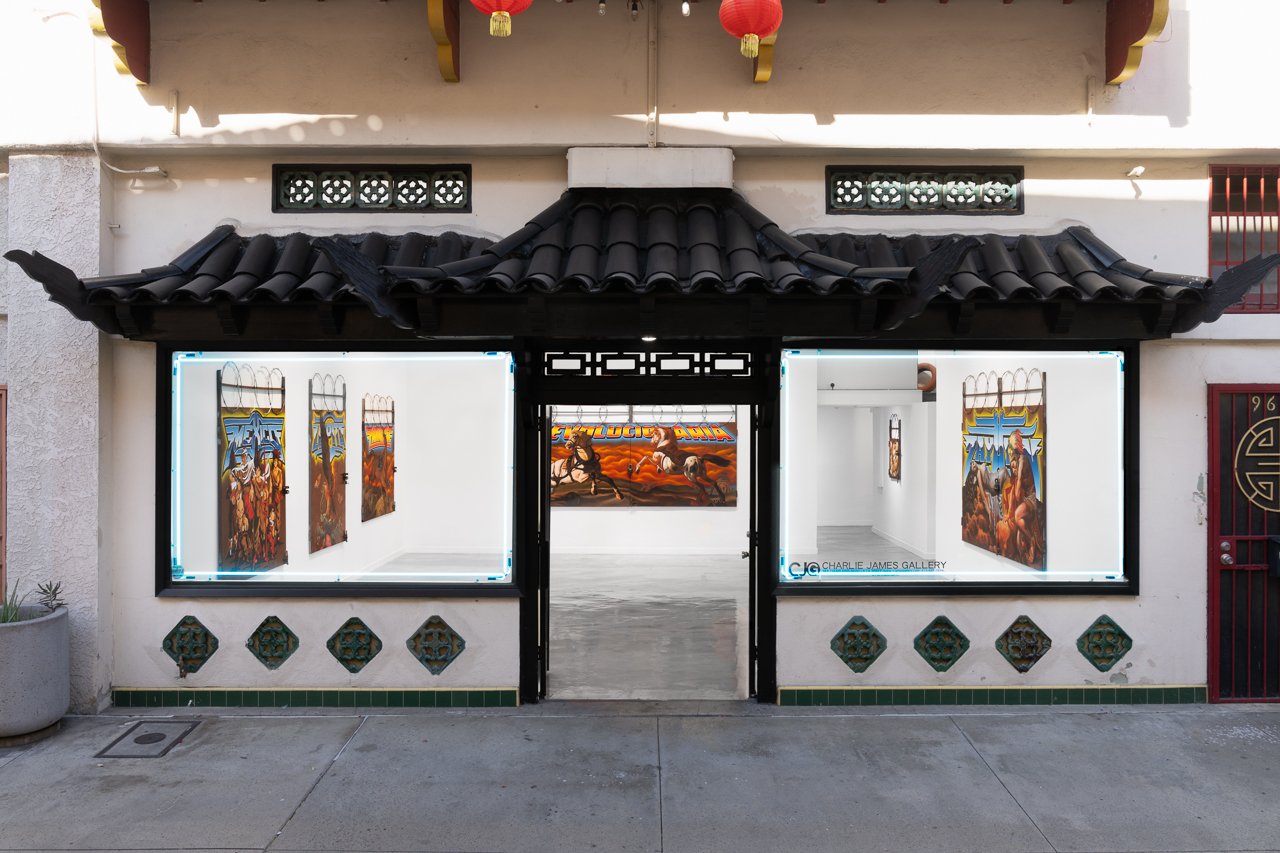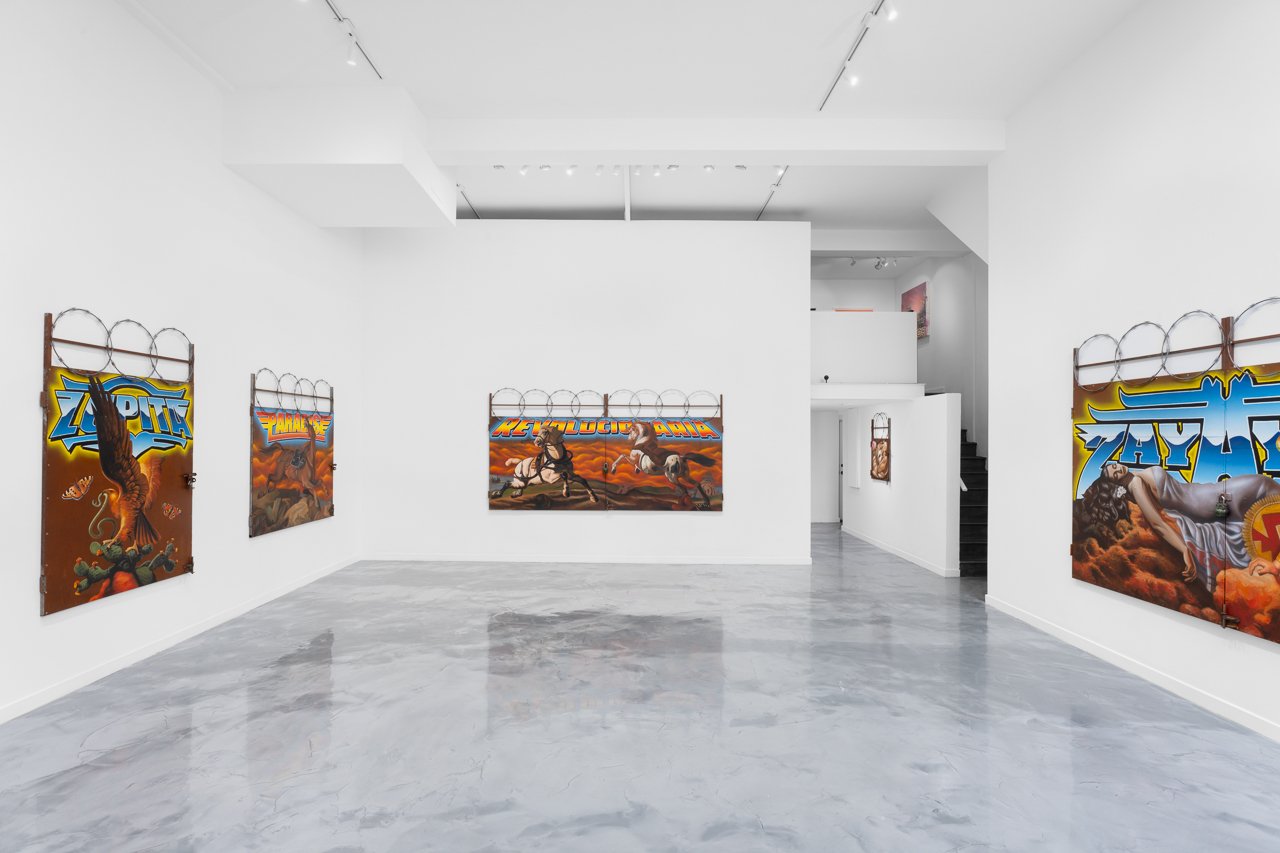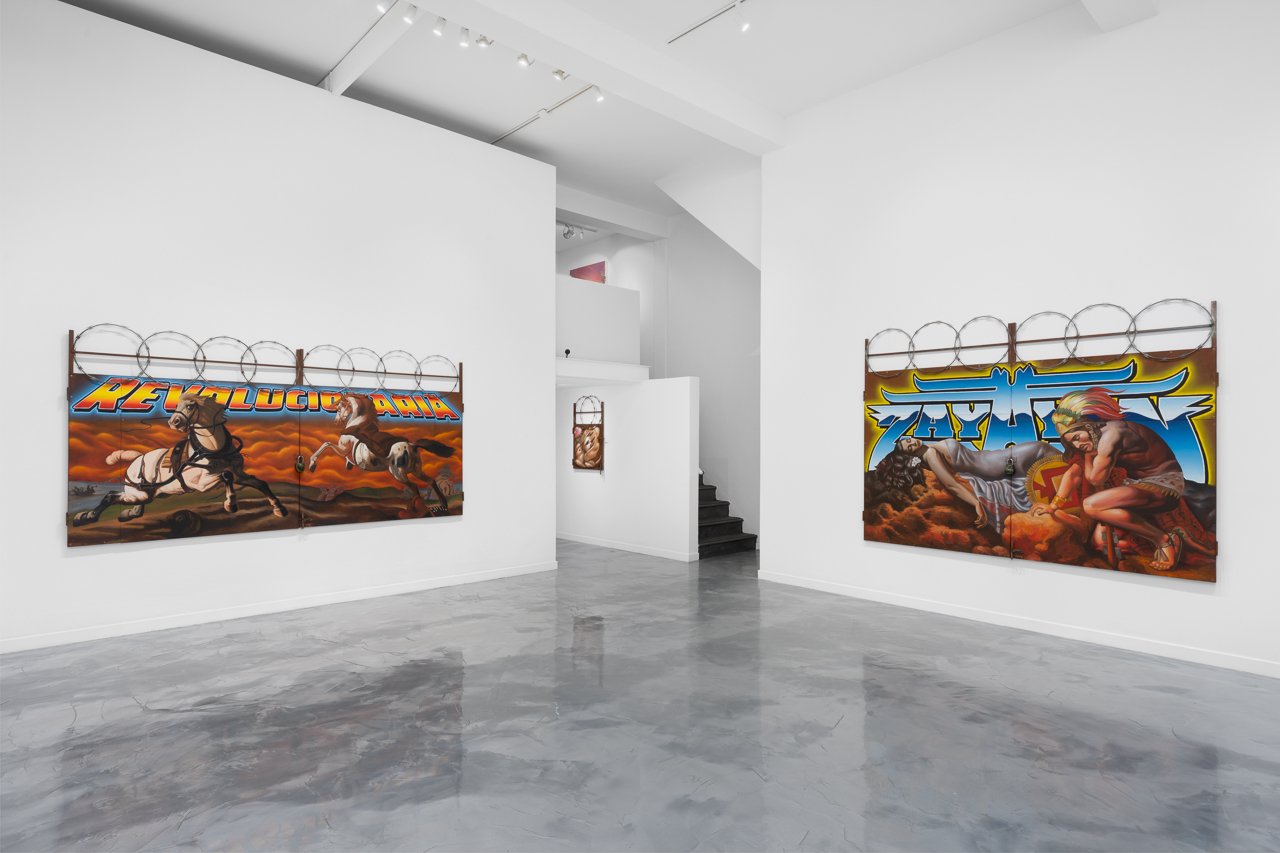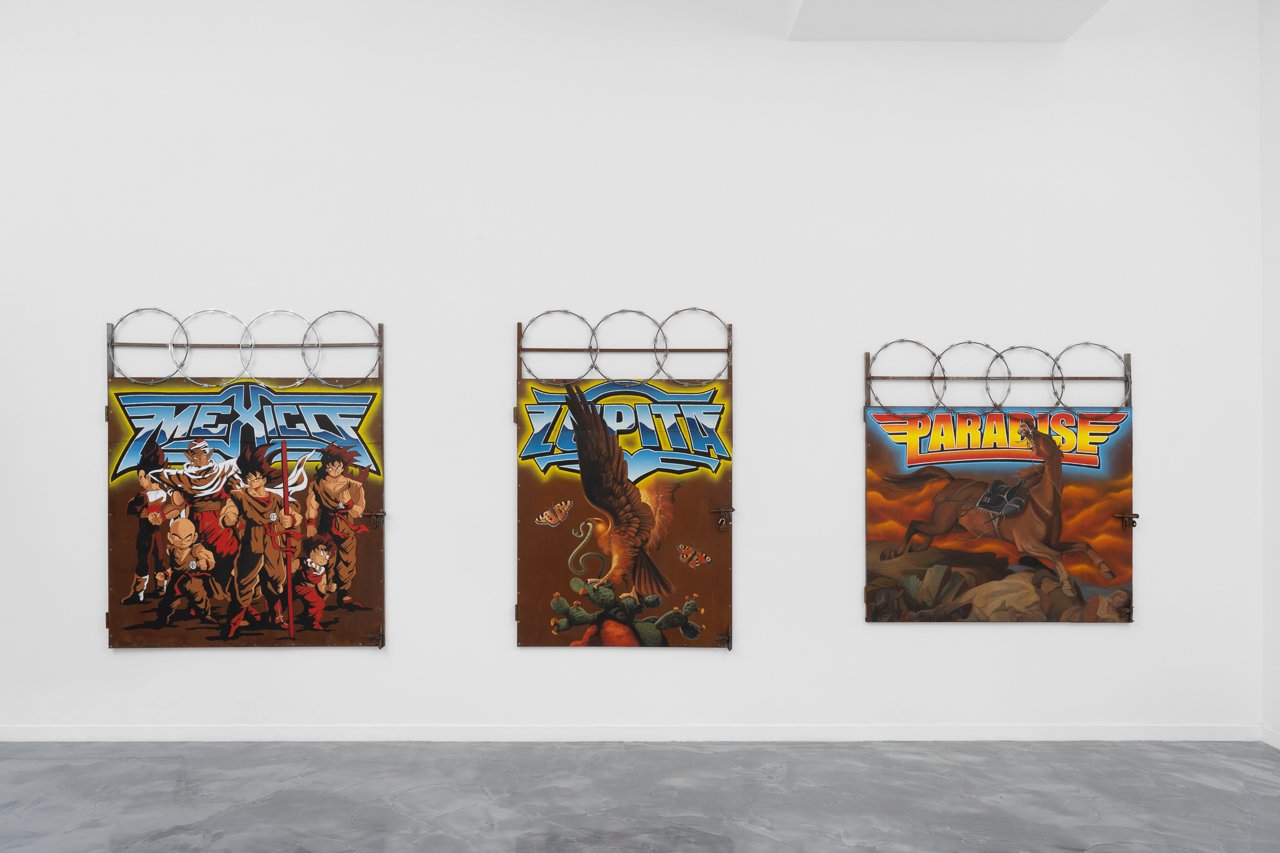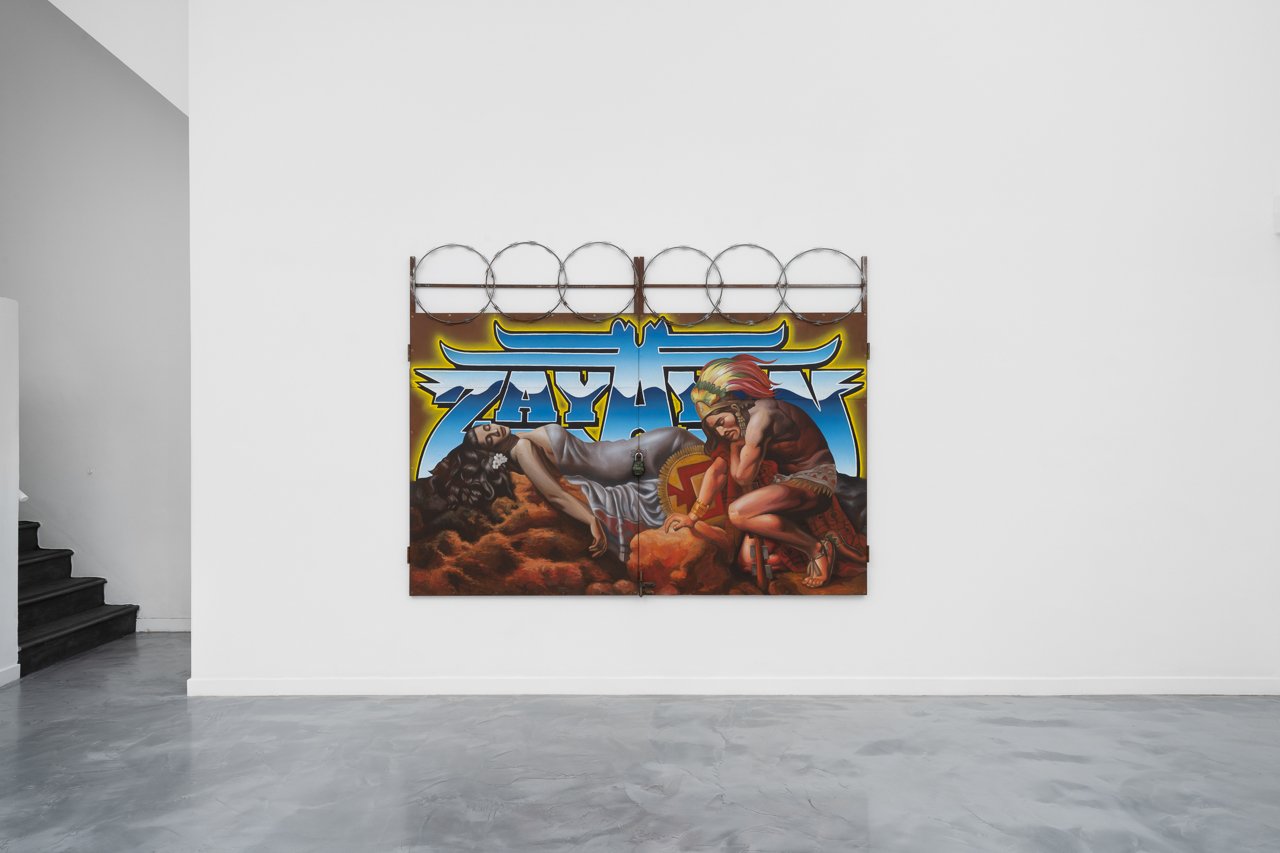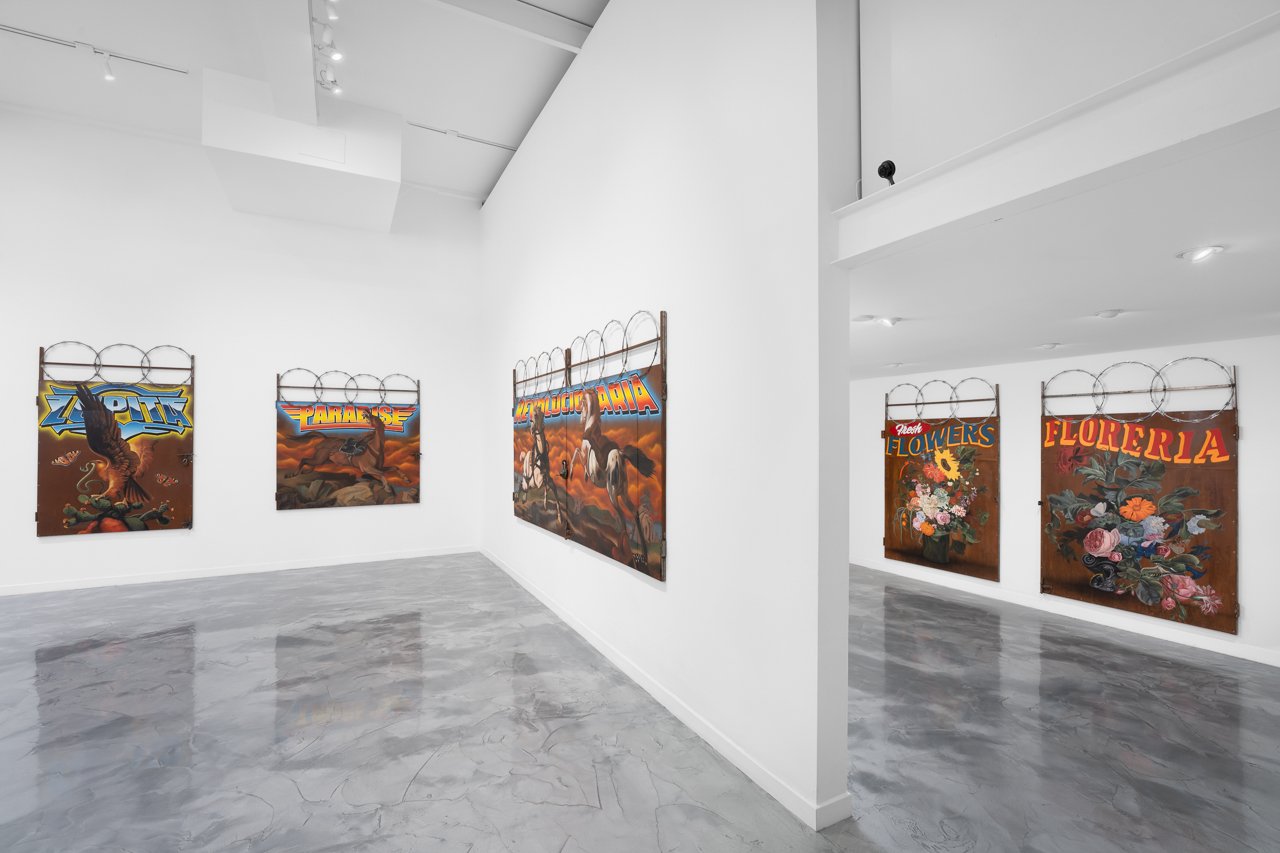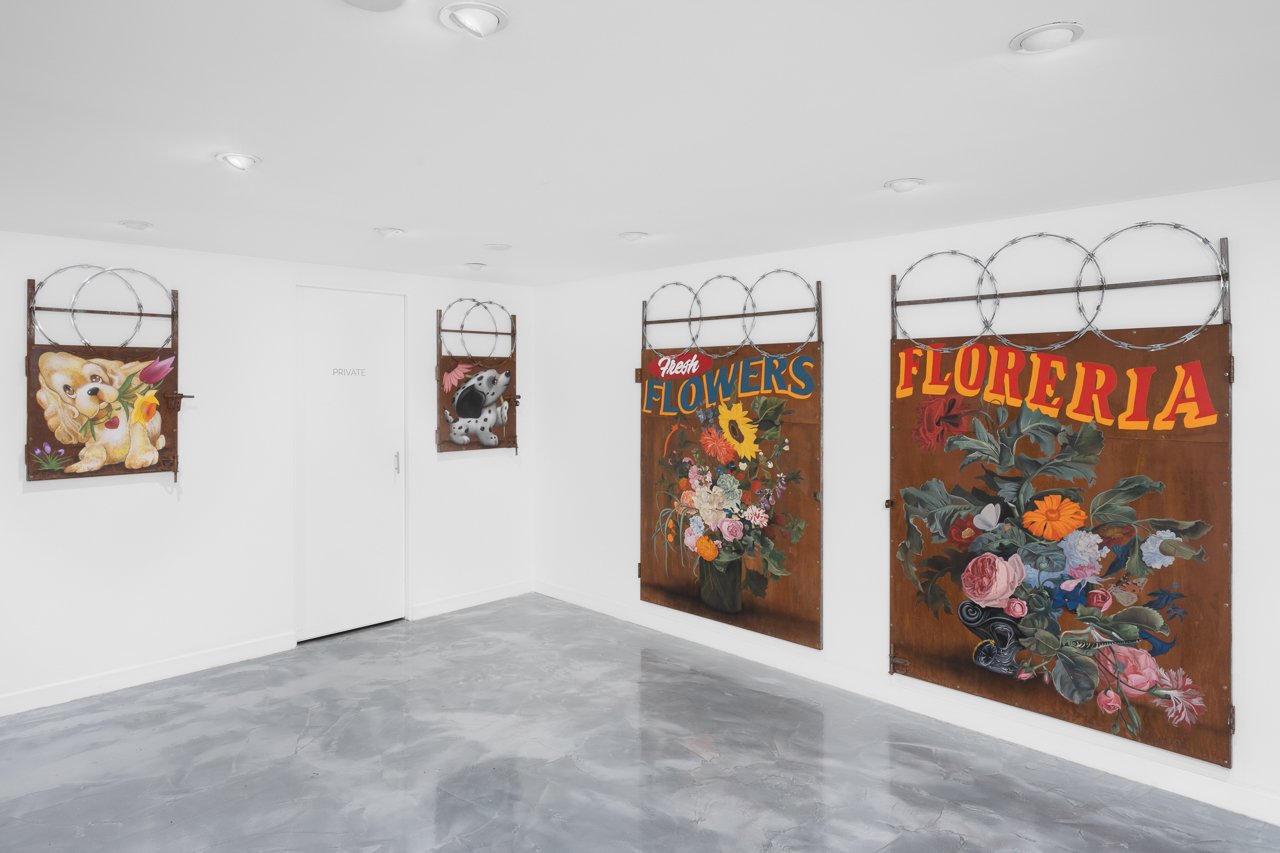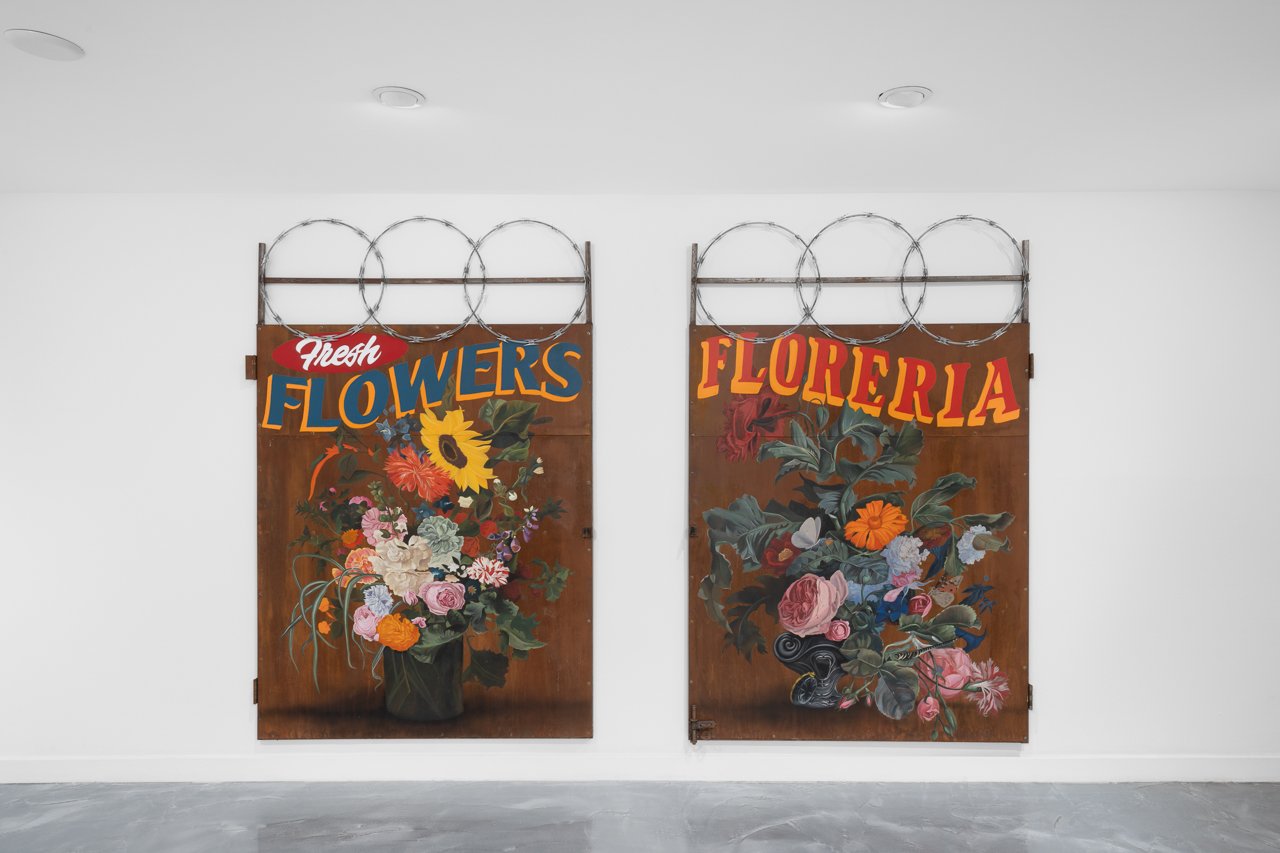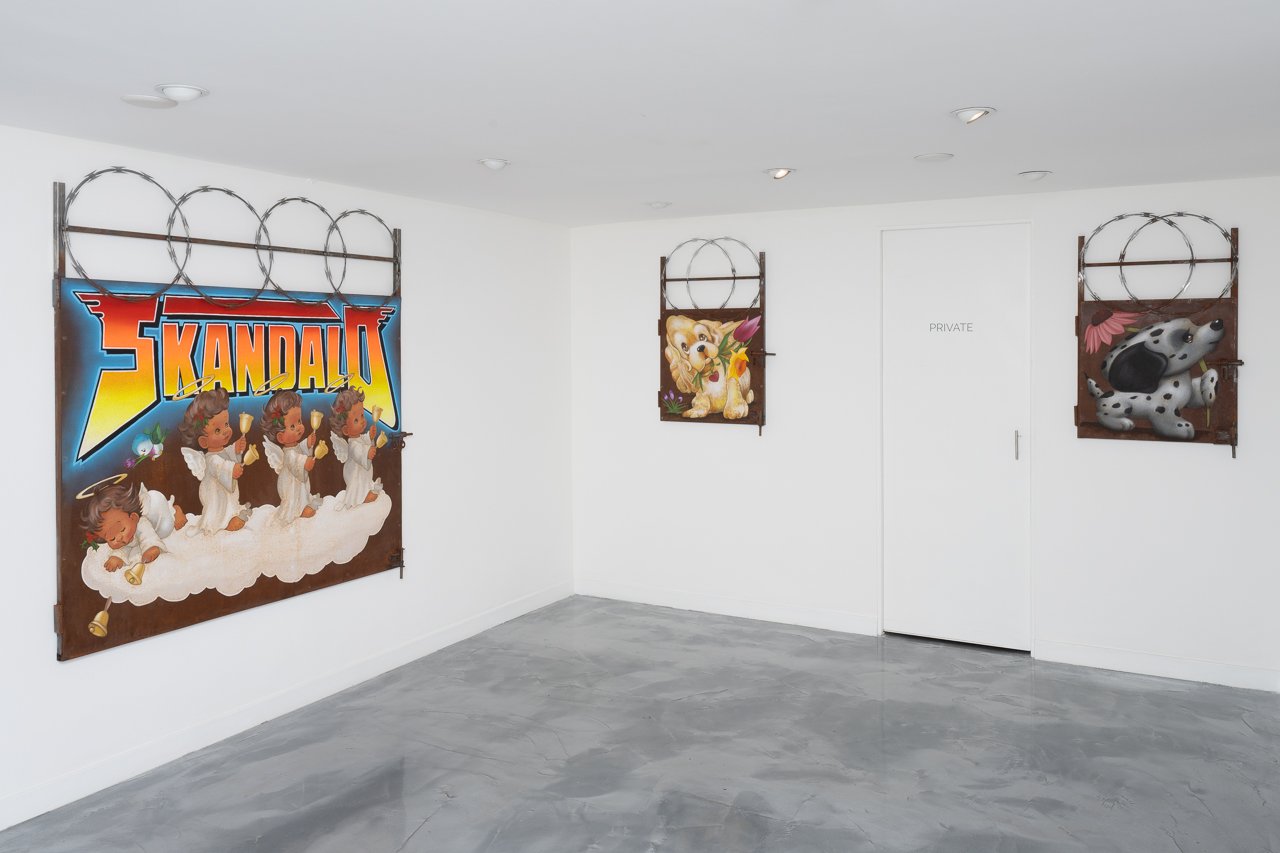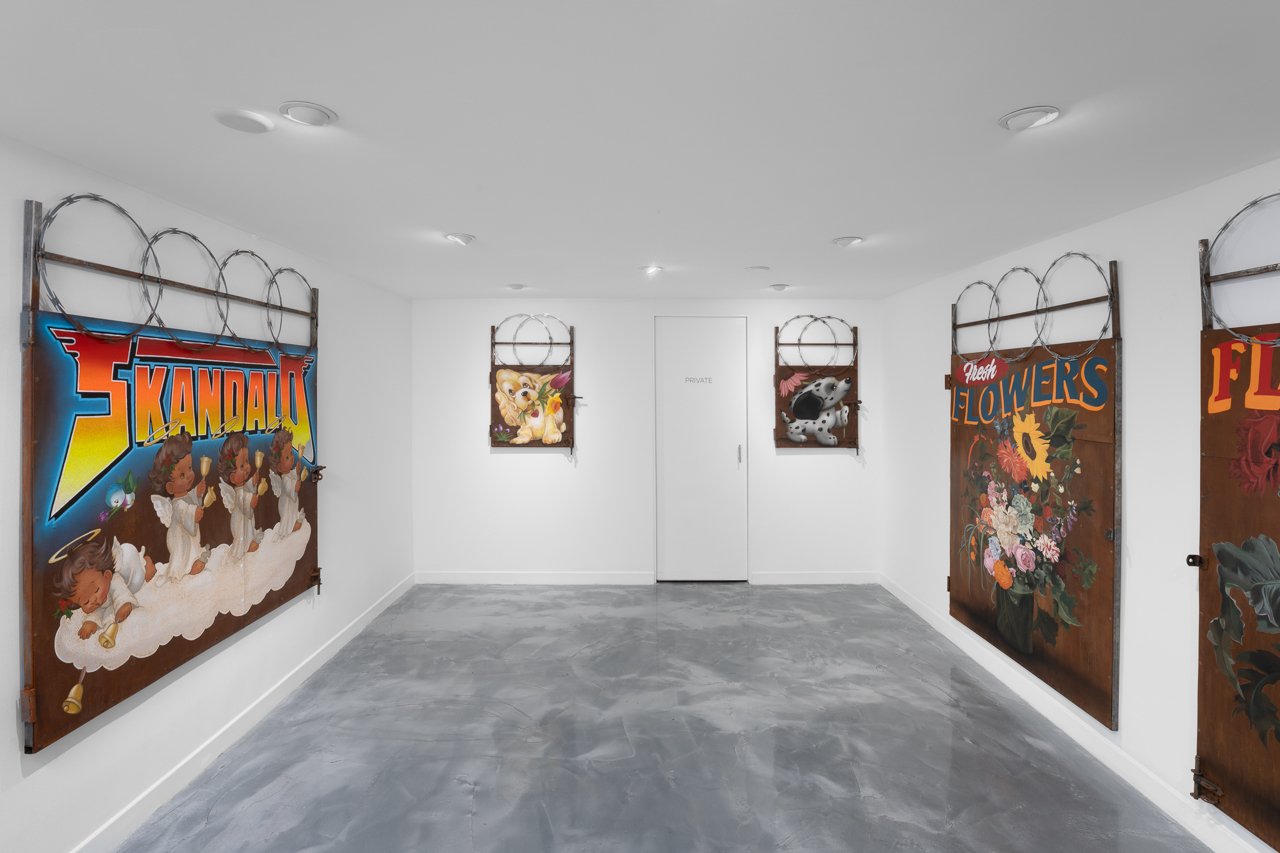OXI-DIOS
Ozzie Juarez
OXI-DIOS
969 Chung King Road
JANUARY 20 - MARCH 2, 2024
SHOW CATALOG (PDF)
PRESS RELEASE (PDF)
Charlie James Gallery is pleased to present Ozzie Juarez: OXI-DIOS, the artist’s first solo exhibition with the gallery and one that features an exciting new group of works that move Juarez’s practice in an entirely new and thrilling direction. OXI-DIOS – a portmanteau of oxido dios, or “oxidized god” – contains a series of paintings on fabricated metal gates that juxtapose historical and contemporary visual sources in compositions that draw you with their softness and detail while at the same time holding you at bay with barbed wire and blaring text. Striking, realist imagery from classical paintings of still lives and battles, romantic scenes from Pre-Columbian myth, and contemporary pop culture heroes grace the rusted expanses, most of which are capped by the emphatic and brightly-colored lettering characteristic of Mexico City’s sonidero scene. Collectively, the works in OXI-DIOS bring to life a particular corner of the Los Angeles landscape, one suffused with Mexican aesthetics, undergirded by cumbia beats, and populated by larger-than-life figures both real and imagined.
The largest painting of the group depicts two frothing battle horses whose riders have just met their ends. The men lie mostly out of view, allowing the muscular horses to take center stage as they dramatically leap across the frame. Neon yellow and orange lettering spans the top of the composition, declaring REVOLUCIONARIA in a font borrowed from the popular sonidero and a sentiment true to the subject matter of the original fray. In a companion piece, a brawny steed vaults through the text PARADISE, as if declaring the destination of his late rider. Two very different registers of grandiosity coexist in these works, pulled from across time: the myth-making power of history painting and the brash masculinity of sonidero culture. They are united here by Juarez’s deft brushwork and a curatorial eye that sees perfection in juxtaposition.
Another focal point of the exhibition depicts the legendary lovers of Popocatépetl and Iztaccíhuatl, whose tragic romance stems from Pre-Columbian myth and remains popular in Mexican folklore to this day. They rest beneath an electric blue title Zayayin, while in a smaller work the mythical golden eagle of Mexico devours his snake as his wings caress the word Lupita. Imagery derived from these classical and ancient sources is ubiquitous in the everyday visual lexicon of murals and signage in Mexico and Mexican-American communities. Juarez divorces these figures from both their art historical and popular contexts, yet the text pairing only amplifies their cultural significance.
The gates supporting these paintings are of the sort that might span the entrance to a scrap yard or auto-body shop: rusted expanses topped with curlicued circles of barbed wire. The prevalence of this kind of barrier in the Los Angeles landscape counteracts any feeling of menace in the hulking forms, yet even on a gallery wall they retain a sense of guardianship, of protection; a barring of entry both visual and physical. This idea is amplified by a set of smaller paintings of guard dogs, which at this scale call to mind aged icons with barbed wire standing in for Gothic architectural excess. The observer can’t help but wonder what these rusted gates might be shielding from view.
Rust often carries a connotation of urban blight; something left untended, its surface a desirable playground for graffiti writers and metal scrappers. Here, Juarez plays with ideas of beauty and ugliness, softness and severity as he juxtaposes hard metal with supple flesh or flower, particularly in Zayayin, Fresh Flowers, and Florería. This rust is the product of a chemical process Juarez developed a talent for when working for Disney finishing sets, which often included artificially aged surfaces, but rust has a mind of its own and the results are often surprising. Its texture is similar to that of a rough paper and its stippled finish shows through areas of the painted surface. The works are inherently sculptural, with their hinges and clasps and barbed wire finish. A small, unique lock adorns each gate and references the culture of swap meets, in which Juarez grew up working with his family and where every tiny object carries a precious and valuable story.
In the downstairs gallery, Juarez has curated a group show entitled Angelitos de Plata, a celebration of over 20 Los Angeles artists working in sculpture, ceramics, painting, photography, and drawing. This community represents a network of influence, support, and inspiration; Juarez refers to them as his guides and his angels. A celebration of community also suffuses Tlaloc Studios, an artist-run studio and exhibition space in South Central spearheaded by Juarez since 2019. Named for the Aztec god of rain, who represents growth, fertility, and abundance, Tlaloc Studios has become a lively space for artists to come together.
Ozzie Juarez (b. 1991, Compton, CA) is a multidisciplinary artist who uses the realms of painting and sculpture to honor and revitalize ancient and recent cultural artifacts, languages, and histories. Inspired by the techniques, collaborations, ambitions, and ephemeral qualities of unsanctioned public art, Juarez incorporates excerpts of paintings he observes across the LA landscape into his own work. His ongoing interest in the construction of shared experiences and identities can be equally attributed to time spent as a scenic painter specializing in physical simulation at Disneyland. The omnipresence of American cartoon culture—with its roots in racial stereotypes and its exoticization of global cultures—weaves itself effortlessly into Juarez’s motifs.
Juarez earned his BFA from the University of California Berkeley. His work has been exhibited in Los Angeles, San Francisco, England, Paris, Miami, and Mexico City and has been featured in publications including Los Angeles Times , Hyperallergic, Juxtapoz magazine, Artillery Magazine, Purple magazine, Yahoo News , LAist, BBC News and El Economista. Juarez is a pillar of the local arts community and in 2020 he founded TLALOC Studios, an artist-run community gallery and studio building in the South Central neighborhood of Los Angeles. TLALOC evolves with its members, providing a space that encourages and promotes the possibility of a sustainable life as an artist, or as Juarez says, “a lifestyle worth living.”
Artist Instagram: @ozziejuarez










